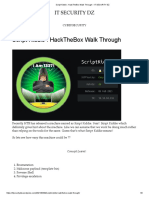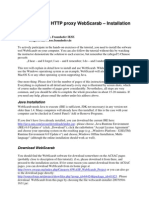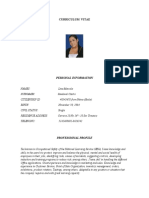0 ratings0% found this document useful (0 votes)
85 viewsCreate Apache Web Server
This document provides instructions for installing Apache web server, PHP, MySQL, and PHPMyAdmin on a Windows system. Key steps include downloading and extracting the necessary files, creating directories for the web server files and web pages, configuring Apache's httpd.conf file to point to the correct locations, installing and configuring PHP and enabling PHP modules, setting up MySQL during installation, and extracting PHPMyAdmin files to complete the installation. Once completed, the basic LAMP stack and PHPMyAdmin will be installed and accessible at specified URLs.
Uploaded by
phibao37Copyright
© © All Rights Reserved
Available Formats
Download as DOCX, PDF, TXT or read online on Scribd
0 ratings0% found this document useful (0 votes)
85 viewsCreate Apache Web Server
This document provides instructions for installing Apache web server, PHP, MySQL, and PHPMyAdmin on a Windows system. Key steps include downloading and extracting the necessary files, creating directories for the web server files and web pages, configuring Apache's httpd.conf file to point to the correct locations, installing and configuring PHP and enabling PHP modules, setting up MySQL during installation, and extracting PHPMyAdmin files to complete the installation. Once completed, the basic LAMP stack and PHPMyAdmin will be installed and accessible at specified URLs.
Uploaded by
phibao37Copyright
© © All Rights Reserved
Available Formats
Download as DOCX, PDF, TXT or read online on Scribd
You are on page 1/ 2
1.
Download Setup File
Apache Server (work on windows 7 and later)
- Visual C++ Redistributable for Visual Studio 2012: download
- Apache: download (choose the latest VC11 win32 version)
PHP
- Php for Windows: download (choose the latest VC11 x86 TS version)
MySQL
- MySQL for Windows: download (choose 5.5.17 x86 MSI version)
PHPMyAdmin
- phpMyAdmin Source: download
2. Install (recommend)
Create these directory:
C
o Web Server
apache
mysql
php
temp
E
o Web
- Install vcredist_x86.exe
- Extract the apache setup file, copy all content in the sub folder (like
Apache24) to C:\Web Server\apache
- Go to C:\Web Server\apache\conf\ and open httpd.conf,
Change the ServerRoot value to "C:/Web Server/apache"
Set the ServerName value as localhost:80
Change the DocumentRoot value to E:/Web
In Directory tag, change attribute from "c:/Apache24/htdocs" to
E:/Web, in this tag, change AllowOverride from None to All
Add index.php to DirectoryIndex
Create file index.html in E:/Web, with any content as html page
- Open the Command Prompt with admin, type the following command:
cd /d C:\Web Server\apache\bin
httpd.exe -k install
httpd.exe -k start
- Open web browser and go to address http://localhost/ to see the result.
- Extract all content in downloaded php source to C:\Web Server\php
- In the httpd.conf still opened, add this code to end of file:
AddType application/x-httpd-php .php
LoadModule php5_module "c:/Web Server/php/php5apache2_4.dll"
PHPIniDir "c:/Web Server/php"
Notice: On the second code, the name php5apache2_4.dll can be different
depend on php version, just open c:/Web Server/php directory to see the exact
name of the module.
- Open C:\Web Server\php directory, rename php.ini-recommended or
php.ini-development to php.ini
- Open php.ini file and add these code to end of file:
doc_root = "e:\Web";
session.save_path = "c:\Web Server\temp";
extension_dir = "C:\Web Server\php\ext";
- With the command prompt still open, type: httpd.exe -k restart to restart
apache server.
- Create file phpinfo.php in E:/Web, with content <?php phpinfo(); ?>, then go
to web browser and go to http://localhost/phpinfo.php to see result
- Start setup mysql, choose Program Files directory as C:\Web
Server\mysql, the type of installation can be Sever only
- In file php.ini, uncomment these module (delete ; at beginning of line)
;extension=php_mbstring
;extension=php_mysql.dll
;extension=php_mysqli.dll
- Restart apache server to take effect
- Extract all content on phpMyAdmin source to E:\Web folder\phpmyadmin, in
this folder, rename file config.sample.inc.php to config.inc.php.
- Go to address http://localhost/phpmyadmin/ to log on.
You might also like
- Configuration of a Simple Samba File Server, Quota and Schedule BackupFrom EverandConfiguration of a Simple Samba File Server, Quota and Schedule BackupNo ratings yet
- Apache Server (HTTP) Interview QuestionsNo ratings yetApache Server (HTTP) Interview Questions4 pages
- Setup of a Graphical User Interface Desktop for Linux Virtual Machine on Cloud PlatformsFrom EverandSetup of a Graphical User Interface Desktop for Linux Virtual Machine on Cloud PlatformsNo ratings yet
- Attacking HTTP Authentication With Hydraâ (Session 1)No ratings yetAttacking HTTP Authentication With Hydraâ (Session 1)12 pages
- WordPress Mass Defacer - Joomla Mass Defacer - PHP Mass Hack ScriptNo ratings yetWordPress Mass Defacer - Joomla Mass Defacer - PHP Mass Hack Script14 pages
- SimAttacker - Vrsion 1 0 0 - Priv8 4 My FriendNo ratings yetSimAttacker - Vrsion 1 0 0 - Priv8 4 My Friend7 pages
- How To Brute Force Your Router in WindowsNo ratings yetHow To Brute Force Your Router in Windows3 pages
- HTB Calamity Write-Up (Ret2mprotect, Bypass NX, Info Leak) - CTF - 0x00sec - The Home of The HackerNo ratings yetHTB Calamity Write-Up (Ret2mprotect, Bypass NX, Info Leak) - CTF - 0x00sec - The Home of The Hacker20 pages
- Install Plugin Cpanel - WHM - Watch MysqlNo ratings yetInstall Plugin Cpanel - WHM - Watch Mysql2 pages
- The Perfect Server - CentOS 6.4 x86 - 64 (Apache2, Dovecot, ISPConfig 3)No ratings yetThe Perfect Server - CentOS 6.4 x86 - 64 (Apache2, Dovecot, ISPConfig 3)19 pages
- SQL Injection Is A Code Injection Technique That Exploits A Security Vulnerability Occurring in The Database Layer of An ApplicationNo ratings yetSQL Injection Is A Code Injection Technique That Exploits A Security Vulnerability Occurring in The Database Layer of An Application6 pages
- Script Kiddie - HackTheBox Walk Through - IT SECURITY DZNo ratings yetScript Kiddie - HackTheBox Walk Through - IT SECURITY DZ9 pages
- Security: XSS Complete Guide All About Cookies and SecurityNo ratings yetSecurity: XSS Complete Guide All About Cookies and Security5 pages
- Who, What, Where, When, Wordlist: @tomnomnomNo ratings yetWho, What, Where, When, Wordlist: @tomnomnom30 pages
- How To Get Logs From The GD-INTIP-GD3-INTIP3No ratings yetHow To Get Logs From The GD-INTIP-GD3-INTIP32 pages
- Pipenv Documentation: Release 2018.11.27.dev0No ratings yetPipenv Documentation: Release 2018.11.27.dev074 pages
- Phishing and Malicious Javascript: John Mitchell100% (3)Phishing and Malicious Javascript: John Mitchell40 pages
- Designing A Captcha System With PHP and MySQLNo ratings yetDesigning A Captcha System With PHP and MySQL9 pages
- TCHydra Kalyani Rajalingham Marielle SarongNo ratings yetTCHydra Kalyani Rajalingham Marielle Sarong6 pages
- SamuraiWTF Course Slides v9.0 - AppSecDC2012No ratings yetSamuraiWTF Course Slides v9.0 - AppSecDC2012163 pages
- HACKING: Unveiling the Secrets of Cybersecurity and Ethical Hacking (2024 Guide for Beginners)From EverandHACKING: Unveiling the Secrets of Cybersecurity and Ethical Hacking (2024 Guide for Beginners)No ratings yet
- Creating and Managing Virtual Machines and Networks Through Microsoft Azure Services for Remote Access ConnectionFrom EverandCreating and Managing Virtual Machines and Networks Through Microsoft Azure Services for Remote Access ConnectionNo ratings yet
- CPF India Private LTD - Compliance Mangement Proposal (June 26th 2024)No ratings yetCPF India Private LTD - Compliance Mangement Proposal (June 26th 2024)22 pages
- Pololu 3pi Robot User's Guide © 2001-2011 Pololu CorporationNo ratings yetPololu 3pi Robot User's Guide © 2001-2011 Pololu Corporation68 pages
- Brief Exercises BE2 - 1: No. Account (A) Debit Effect (B) Credit Effect (C) Normal Balance83% (6)Brief Exercises BE2 - 1: No. Account (A) Debit Effect (B) Credit Effect (C) Normal Balance6 pages
- Invertis University, Bareilly: First Shift - Block 3 Second Shift - Block 1 & 2 Odd Semester Examination 2018-19No ratings yetInvertis University, Bareilly: First Shift - Block 3 Second Shift - Block 1 & 2 Odd Semester Examination 2018-1914 pages
- Help Children Be Grateful Pray-Ers: NovemberNo ratings yetHelp Children Be Grateful Pray-Ers: November4 pages
- Close Reading From by Rodman Philbrick (Pg. 1 3) : Freak The MightyNo ratings yetClose Reading From by Rodman Philbrick (Pg. 1 3) : Freak The Mighty2 pages
- Get Principles of Biomedical Engineering Second Edition Sundararajan Madihally free all chapters100% (3)Get Principles of Biomedical Engineering Second Edition Sundararajan Madihally free all chapters45 pages
- Musuko Ga Kawaikute Shikataganai Mazoku No Hahaoya Vol.9 Chapter 200 Successor - ManganeloNo ratings yetMusuko Ga Kawaikute Shikataganai Mazoku No Hahaoya Vol.9 Chapter 200 Successor - Manganelo1 page
- Classification of Articulators: Awni Rihani, D.D.S., M.Sc.No ratings yetClassification of Articulators: Awni Rihani, D.D.S., M.Sc.4 pages
- Telephone Billing System Project AbstractNo ratings yetTelephone Billing System Project Abstract2 pages

























































































